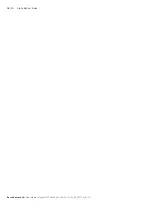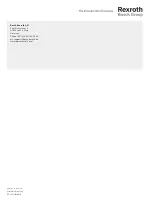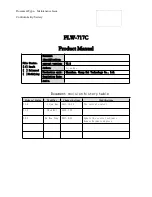
26/40 Installation
Bosch Rexroth AG
, Manifold block type AGEV1-48404-AA/HM/L01H01-XC, RE 62272-B/03.19
CAUTION
Insufficient installation space!
Risk of getting caught and crushing! Insufficient installation space may lead to
jamming or abrasions during actuation and setting work on the hydraulic block.
▶
Make sure that the installation space is sufficient and that actuating and
adjustment elements as well as plug-in connections are easily accessible.
Leaking hydraulic fluid!
Hydraulic fluid may leak during mounting and demounting of hydraulic components.
Consequently, persons may slip or fall.
▶
Only remove protective caps from hydraulic blocks directly prior to their
installation.
▶
Immediately remove spilled hydraulic fluid and dispose of it properly.
Faulty mounting!
Mixing the ports on the manifold block up may lead to damage to parts of the
hydraulic system, of the manifold block and of mounted components.
▶
Observe the marking of customer connections on the manifold block and on the
assembly drawing.
NOTICE
Missing seals and plugs!
Liquids and foreign particles may penetrate and damage the product.
▶
Before starting the installation make sure that all seals and plugs of connections
are tight.
Hydraulic pipes and hoses installed under stress!
Damage to the manifold block! Hydraulic pipes and hoses, which are installed
under mechanical stress, generate additional mechanical forces during operation,
which reduces the service life of the manifold block and the system as a whole.
▶
Install pipes and hoses without stress.
7.7.1 Mounting the manifold block mechanically
Mount the manifold block completely at the mounting bores provided for this and
tighten the specified number of mounting screws to the tightening torque specified
on the installation drawing.
7.7.2 Connecting the manifold block hydraulically
1.
Depressurize the relevant system part.
2.
Establish all connections and observe the hydraulic circuit diagrams of the
system.
3.
Make sure that pipes and/or hoses are connected to all ports and/or that the
ports are closed with plug screws.
4.
Check to make sure that the cap nuts and flanges are correctly tightened at the
pipe fittings and flanges.
5.
Make sure that all pipes and hose lines and every combination of connection
pieces, couplings or connection points with hoses or pipes are checked for their
operational safety by a person with appropriate knowledge and experience.














































